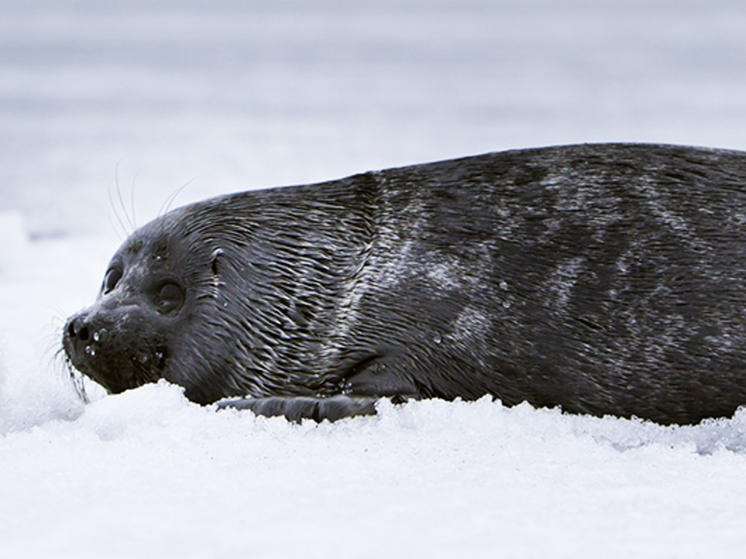Members of the scientific conference shared the results of expeditions on the lake
Why does the Baikal seal need a neural network, how deep-sea fish survive in museum aquariums and who has recently populated the deepest lake on the planet, Russian scientists said.
 Seal on the ice.
Seal on the ice.
The results of expeditionary research were summed up not long ago at a special conference organized by the Ministry of Education and Science.
Director of the Baikal Museum of the Siberian Branch of the Russian Academy of Sciences Alexander Kupchinsky shared the results of nine expeditions conducted by his employees in 2023.
< p style="text-align: center;">
One of the main topics for museum biologists is currently counting the Baikal seal (nerpa).
“It is believed that there are 160 thousand of them, there are even proposals to open a seal hunt, – says Kupchinsky. – But in our opinion, this figure is overestimated – it would be necessary to clarify it, and this requires new methods. We want to apply a neural network for operations with big data, because old counting methods no longer work.» /image/70/45/70/1e/2bbdffb0b3de110256531838e663a91c.jpg» class=»article__picture-image» alt=»» />View of the Ushkany Islands of Lake Baikal.
The fact is that counting seals in the old “manual” way the method required the collection of an entire expedition, which for several months cut through the ice of Lake Baikal from south to north in search of seals. To get closer to the seals on the Ushkany Islands, people disguised themselves by throwing a white cloth over themselves, lured individual “music lovers”… with music, starting a gramophone for them right in the boat. Now museum staff want to count animals using drones, – they are assisted in this by employees of the Moscow Institute of Civil Aviation.
I personally heard about another type of research for the first time: museum scientists are acclimating deep-sea Baikal fish to life in aquariums. Previously, according to Kupchinsky, they did not survive longer than a week in captivity. Scientists have set a task – to increase their lifespan as living museum “exhibits”. They resorted to a variety of methods: they pumped clean Baikal water into aquariums from a depth of about 400 meters, they even lifted fish from the depths, like divers, using modes decompression, but nothing helped. And then one day someone proposed an unexpected solution – salt the water in the aquarium.

«We salted fresh Baikal water to just 3-4 ppm, and it worked amazingly, – says Kupchinsky. – Now deep-sea species, such as golomyanka, which previously did not live up to five days, live in the museum for two months.
The museum conducts expeditions, usually complex ones, – In addition to seals and fish, birds and the microbiota of the lake are also studied. Thus, ornithologists who conduct fundamental long-term observations recently noticed a cormorant on Lake Baikal, which had not been seen in those parts since the 40-50s of the last century, when it almost completely migrated to the south. Now he has returned, and scientists do not yet know what this is connected with.
Last year, specialists opened a new direction — the study of Baikal mushrooms and their effect on microplastics, which are becoming more and more abundant under water. «They're picking mushrooms» on Baikal as follows: special traps are placed at a depth of 6 and 15 meters for the biota to inhabit, and every three months they bring its samples to the surface. According to Kupchinsky, among the mushrooms there are endemics of Baikal that have never been found anywhere else before, and there are, for example, those that can be found even in Antarctic waters!
Another endemic lives in Baikal — Baikal omul – valuable salmon fish, the catching of which is now prohibited, but for some reason there is no less of it on the market… Scientists involved in assessing its reserves are in a very difficult position. The fact is that, according to the director of the Limnological Institute of the SB RAS Andrei Fedotov, the omul has changed its behavior.
“This year he showed an unusual dynamic characteristic, – says the director of LIN SB RAS. – If earlier he could stand for days in one place and not change location, now, as if he senses our trawl and leaves. Maybe he learned to hear the noise of our research vessel.” This, of course, interferes with the salmon count.
Limnologists study the problem of invaders in Baikal. Previously, for example, caddis flies or pond snails that lived in shallow reservoirs did not penetrate Baikal water. Now experts are observing the already familiar picture of caddisfly butterflies fluttering out from under the water, the larvae of which matured at the bottom of the lake.
«At the same time, we are not observing any fundamental changes in the chemical composition of the water, nor is it warming not observed, – says Fedotov. – Perhaps some changes are occurring at the level of biophysics. Spirogyra algae was also not native to our lake before; if it was found, it was only a few threads at a depth of 1-2 meters. But now it has bloomed rapidly in Baikal water, penetrating even to a depth of 10-15 (!) meters.” Diatoms also surprise scientists: for example, 400 thousand years ago in Baikal they were represented by large species, now small ones grow there. In addition, the round ones have been replaced by elongated ones…
Among other things, the geology of Lake Baikal is also interesting, which is expanding at a rate of 4.2 mm per year. Someday it will turn into a sea, but given that the expansion process has been going on for the last 30-50 million years, this will not happen in our lifetime.




















































Свежие комментарии